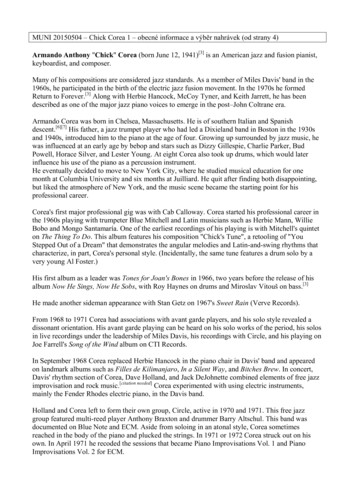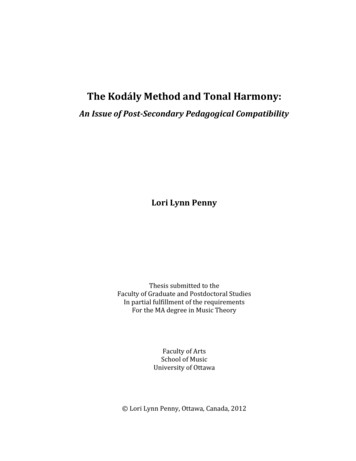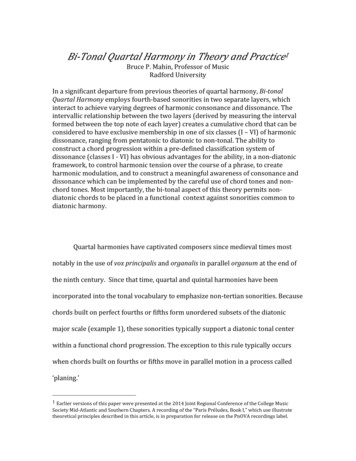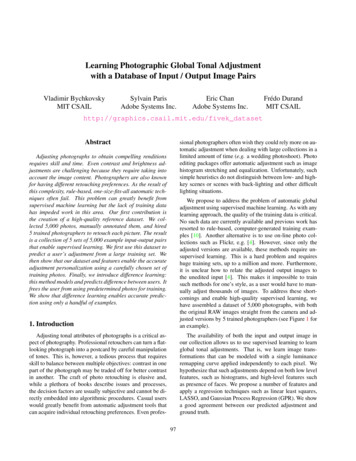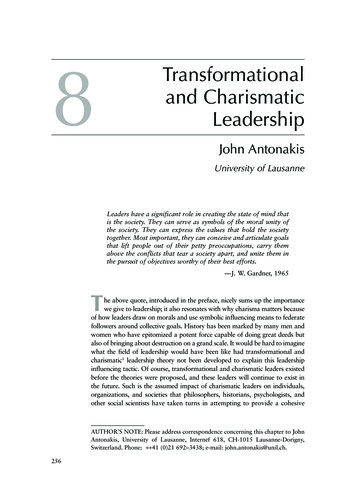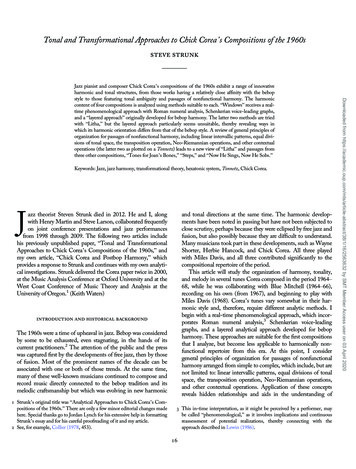
Transcription
Tonal and Transformational Approaches to Chick Corea’s Compositions of the 1960s Keywords: Jazz, jazz harmony, transformational theory, hexatonic system, Tonnetz, Chick Corea.Jand tonal directions at the same time. The harmonic developments have been noted in passing but have not been subjected toclose scrutiny, perhaps because they were eclipsed by free jazz andfusion, but also possibly because they are difficult to understand.Many musicians took part in these developments, such as WayneShorter, Herbie Hancock, and Chick Corea. All three playedwith Miles Davis, and all three contributed significantly to thecompositional repertoire of the period.This article will study the organization of harmony, tonality,and melody in several tunes Corea composed in the period 1964–68, while he was collaborating with Blue Mitchell (1964–66),recording on his own (from 1967), and beginning to play withMiles Davis (1968). Corea’s tunes vary somewhat in their harmonic style and, therefore, require different analytic methods. Ibegin with a real-time phenomenological approach, which incorporates Roman numeral analysis,3 Schenkerian voice-leadinggraphs, and a layered analytical approach developed for bebopharmony. These approaches are suitable for the first compositionsthat I analyze, but become less applicable to harmonically nonfunctional repertoire from this era. At this point, I considergeneral principles of organization for passages of nonfunctionalharmony arranged from simple to complex, which include, but arenot limited to: linear intervallic patterns, equal divisions of tonalspace, the transposition operation, Neo-Riemannian operations,and other contextual operations. Application of these conceptsreveals hidden relationships and aids in the understanding ofazz theorist Steven Strunk died in 2012. He and I, alongwith Henry Martin and Steve Larson, collaborated frequentlyon joint conference presentations and jazz performancesfrom 1998 through 2009. The following two articles includehis previously unpublished paper, “Tonal and TransformationalApproaches to Chick Corea’s Compositions of the 1960s,” andmy own article, “Chick Corea and Postbop Harmony,” whichprovides a response to Strunk and continues with my own analytical investigations. Strunk delivered the Corea paper twice in 2000,at the Music Analysis Conference at Oxford University and at theWest Coast Conference of Music Theory and Analysis at theUniversity of Oregon.1 (Keith Waters) The 1960s were a time of upheaval in jazz. Bebop was consideredby some to be exhausted, even stagnating, in the hands of itscurrent practitioners.2 The attention of the public and the presswas captured first by the developments of free jazz, then by thoseof fusion. Most of the prominent names of the decade can beassociated with one or both of those trends. At the same time,many of these well-known musicians continued to compose andrecord music directly connected to the bebop tradition and itsmelodic craftsmanship but which was evolving in new harmonic Strunk’s original title was “Analytical Approaches to Chick Corea’s Compositions of the 1960s.” There are only a few minor editorial changes madehere. Special thanks go to Jordan Lynch for his extensive help in formattingStrunk’s essay and for his careful proofreading of it and my article. See, for example, Collier (1978, 453). This in-time interpretation, as it might be perceived by a performer, maybe called “phenomenological,” as it involves implications and continuousreassessment of potential realizations, thereby connecting with theapproach described in Lewin (1986). Downloaded from /16/2563632 by SMT Member Access user on 03 April 2020Jazz pianist and composer Chick Corea’s compositions of the 1960s exhibit a range of innovativeharmonic and tonal structures, from those works having a relatively close affinity with the bebopstyle to those featuring tonal ambiguity and passages of nonfunctional harmony. The harmoniccontent of four compositions is analyzed using methods suitable to each. “Windows” receives a realtime phenomenological approach with Roman numeral analysis, Schenkerian voice-leading graphs,and a “layered approach” originally developed for bebop harmony. The latter two methods are triedwith “Litha,” but the layered approach particularly seems unsuitable, thereby revealing ways inwhich its harmonic orientation differs from that of the bebop style. A review of general principles oforganization for passages of nonfunctional harmony, including linear intervallic patterns, equal divisions of tonal space, the transposition operation, Neo-Riemannian operations, and other contextualoperations (the latter two as plotted on a Tonnetz) leads to a new view of “Litha” and passages fromthree other compositions, “Tones for Joan’s Bones,” “Steps,” and “Now He Sings, Now He Sobs.”
’ nonfunctional passages in Corea’s tunes. The first approach,called an “experiential” interpretation, will demonstrate how a listener’s understanding of tonality and harmonic meaning mightdevelop as a piece unfolds in time. “ ”Corea’s “Windows” (1966) is an interesting study in tonal andharmonic ambiguity (Example 1).4 Upon hearing the openingBm7 chord, we assume that it must be the tonic. As the melodyarpeggiates through A5, we may remember that tonic chords inminor do not often have independent minor sevenths, and asA Ø7 follows, the most likely interpretation becomes ii7–viiØ7 inA, with a second possibility of iv7–iiØ7 in F minor.5 However,the independent seventh, A5, is also somewhat unusual on a ivchord, and the B 4 of m. 6 is quite unexpected on a iiØ7 in F minor. Perhaps, after the next move to D 7 (V7) with its B 4melody, we should expect F major. The following cadence on F minor (m. 9) then comes as a surprise. At this point the evidentinterpretation is either F minor: iv7–iiØ7–V7–i or perhaps a movefrom a B-minor tonic to a ii–V–i cadence on the minor dominant,F minor.The next chord, Am7/D, requires a new key for its interpretation: F m to Am7 would happen most naturally in E major, as amajor scale-derived subdominant (ii) changing to a minor scale Corea (1994, 117). In this discussion, I enharmonically maintain Corea’s chord labels,although chords such as A Ø7 may be more accurately rendered as G Ø7(when progressing ultimately to F minor). In later discussions here (theSchenkerian and layered approaches), I replace the enharmonic notation ofthe lead sheet with diatonic spellings. Throughout, I will replace Corea’slead sheet “triangle” chord symbol with “maj7” in the text but not in thegraphs.derived subdominant (iv7) in support of the line C –C –B,assuming that the next chord contains a B. The D in the bass ofthe Am7 produces a iv7/ VII, one of the usual substitutes for iv.6One could also hear the move from F m to Am as a transposition(T3),7 which stresses the chromatic third relationship of the twotriads.8 The melodic C 5 does move to B4 harmonized byEmaj7, completing the progression ii–iv7/ VII–I in E. All is notperfectly clear, however, as the A 4 returns in m. 19 to suggestthat the Emaj7 may be IV, not I. This interpretation would againset the first chord, Bm7, as tonic.No confirmation of the role of Emaj7 as IV is given by thenext chord, A 7, which, if E were tonic, might be destined toact as V7 of vi. Again, the ideas of triadic transposition (T4 thistime) and chromatic third relationship assert themselves in thisrather surprising move. During mm. 25–32 the A 7 is prolonged by a chromatic upper neighbor chord, A7, which fourtimes departs from and returns to the A 7, and thereby tells usnothing about the function of the Emaj7 or the A 7 itself. (TheA7 may also be thought of as a substitute dominant replacingE 7, V of A .) The return to Emaj7 at m. 33 is again a surprise, See the discussion of “subdominant modal intensification” and subdominant substitution sets in Strunk (1979). The chord iv7/ VII is not listed assuch, but as it is equivalent to VII dominant seventh sus4; the listed VIIdominant seventh (a dominant seventh built on the subtonic) qualifies it asa minor subdominant representative. This article uses conventions of notation for operations derived from Rahn(1980). Rahn distinguishes between pitch-class transposition and pitchtransposition. The former is labeled by Tn, in which the letter “T” indicates pitch-class transposition and the “n” indicates the level of transposition in semitones (mod 12) counted upward by definition. The latter islabeled by Tpn, in which the combination “Tp” indicates pitch transposition and the “n” indicates the level of transposition in semitones either upor down (not mod 12) allowing “n” to be any positive or negative integer. Corea often uses chromatic third relationships in his compositions (Strunk1999).Downloaded from /16/2563632 by SMT Member Access user on 03 April 2020 . Published lead sheet for “Windows.” By Chick Corea Copyright 1978 UNIVERSAL MUSIC CORP. This arrangementCopyright 2014 UNIVERSAL MUSIC CORP. All Rights Reserved. Used by Permission. Reprinted by Permission of Hal LeonardCorporation.
( )but it does invalidate the idea that the A 7 might be V7 of vi(C minor)—unless one can hear the Emaj7 as the third, fifth,seventh, and ninth of C m, which is, in my opinion, an unlikelyinterpretation. Most importantly, the return to Emaj7 at m. 33enables us to describe the A 7 as an embellishing chord in relation to the Emaj7.9 As such, it is a nonfunctional chord in thiscontext.At last the key of B is confirmed in mm. 33–37 by a normativediatonic progression, Emaj7–D m7–C m7–C m7/B–B Ø7(IV7–passing iii7–ii7–passing ii42 –viiØ7). The Emaj7 at m. l7 isalso confirmed as IV. From the Emaj7, the piece follows a circleof-fifths progression arranged with mostly stepwise bass motionleading to C 7, which will probably function as V of V. Thechords form the usual ii–V groups of bebop (B Ø7–E 7, A m7–D 7). The chords at mm. 35–41, which progress from C minorto A minor, provide a varied transposition (T2) of mm. 1–12(which progress from B minor to F minor).One unexpected progression remains, D 7 to Emaj7 at mm.44–45. Again, triadic transposition (T3) and the chromaticthird relationship are expressed, followed by the return of theprogression at m. 33. The third chord of that progression,C m7 (m. 35), moved to a dominant substitute chord, B Ø7(viiØ7); similarly the corresponding C m7 (m. 47) moves to adominant substitute, the C7 ( II dominant seventh). The latterchord sends the performer back to the beginning Bm7 foranother chorus. Was the C 7 the V7 of V or was it, like the A 7,nonfunctional? Yes, it was V7 of V, if one waits for its resolutionto the substitute dominant C7. Here, the surface emphasis onthe chromatic third relationship masks the normative middleground progression to the dominant. “ ”Having arrived at a general idea of the tonal structure of“Windows,” we can consider a Schenkerian voice-leading graph.10 Iwill present two different graphs, each reflecting a distinct point of The term as used here appears in Salzer (1962, 105, fn. 2). For discussion of the applicability of Schenkerian analysis to jazz, seeLarson (1998) and Martin (1996, especially Chapter 2).view. “Windows” has much in common with bebop and makes useof many of its typical harmonic progressions. However, “Windows”asserts some new tonal characteristics not generally associated withbebop. An analyst can choose to stress either the former or the latterview.Example 2, a middleground graph, stresses the newer harmonic elements. This graph relies on the emphasis given to theEmaj7 (IV) throughout the piece, as well as the lack of a literalV chord, to suggest that “Windows” relies on a tonic-subdominant axis, in which a subdominant chord replaces the usualstructural dominant.11 The graph shows IV prolonged by twoembellishing chords, labeled “EM” below their bass notes: G 7above it (m. 25) returning to IV at m. 33, and C 7 below it(m. 43) returning to IV at m. 45.12 Both these chords are in anonfunctional chromatic third relationship with IV. The bassline strongly supports the interpretation of a subdominant axis,especially given the brief passing nature of the substitute dominant C7 at m. 48, the only dominant-functioning chord in thepiece’s tonic key.The presence of clear tonic-subdominant axes in some 1960scompositions of Wayne Shorter supports applying the axis to“Windows.” The upper voice seems to be a 3-line that changesfrom minor to major at m. 25, but its harmonization is not that ofthe usual Ursatz. The change to a major tonic at the end takes intoaccount Corea’s recorded performances of the period,13 whichprovide a coda that prolongs a major tonic after the final chorus.14 In explaining harmonic developments of the nineteenth century, some analysts have suggested that in many late nineteenth-century compositions theusual tonic-dominant harmonic axis may have been replaced by a tonicsubdominant axis, also called a plagal axis. See, for example, Stein (1983).Because I take the position here that “Windows” has such an axis, I do notcall the IV chord, which is prolonged from mm. 17–45, an embellishingchord as some might. Remember that Corea’s enharmonic chord labels are changed here toreflect their diatonic function: m. 25 is now indicated as G 7 rather thanA 7. Other performers loop back to the beginning (Strunk 1998). The 10-7 linear intervallic pattern noted in mm. 37–44 corrects the 10-6pattern (based on misleading Real Book notation) presented in Strunk(1996, 85).Downloaded from /16/2563632 by SMT Member Access user on 03 April 2020 . “Windows” middleground gr
Jazz pianist and composer Chick Corea’s compositions of the 1960s exhibit a range of innovative harmonic and tonal structures, from those works having a relatively close affinity with the bebop style to those featuring tonal ambiguity and passages of nonfunctional harmony.
